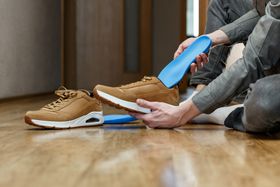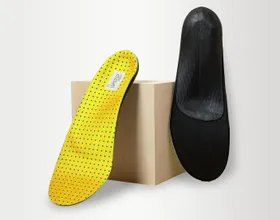Best Exercises for Your Achilles Tendon
Updated December 18, 2024

Achilles tendonitis refers to the inflammation of the Achilles tendon due to overloading. Using custom orthotics for Achilles tendonitis, the pressure transmitted through the Achilles tendon can be redistributed, lowering the tension and reducing the pain.
This article looks at the causes and symptoms of the two different types of Achilles tendonitis and discusses a few conservative treatment exercises you can perform at home in addition to wearing orthotics.
Causes of Achilles Tendonitis
While there may be no specific cause of Achilles tendonitis, the inflammation is thought to result from overuse or a sudden increase in activity. It is common among people who are above 40 years, participate in sports and high-impact activities.
Several other factors which also put you at risk of developing Achilles tendonitis include:
- Obesity
- Improper footwear
- Uneven exercise surface
- Cold weather
- Pre-existing medical conditions (like psoriasis and hypertension)
- Use of quinolone (a type of antibiotic)
» Learn how to prevent Achilles tendonitis with these must-know strategies
Symptoms of Achilles Tendonitis
Among all the symptoms of Achilles tendonitis, pain at the back of the heel or above the heel during activity is the most characteristic. The pain tends to get worse in the morning and after rest.
Other possible symptoms are:
- Ankle stiffness
- Tendon tightness
- Swelling
- Tenderness
- Heat around the tendon
- Difficulty with walking.
Types of Achilles Tendonitis
Depending on what part of the Achilles tendon is affected, Achilles tendonitis may be of two types:
- Insertional As the name implies, it occurs at the point of attachment of the tendon to the heel bone. Primarily, it is characterized by micro-tears, swelling, thickening, or even bony spurs. Insertional tendonitis is common in people with Haglund deformity and is more difficult to treat than mid-portion tendonitis.
- Mid-portion Affects the fibers in the middle portion of the tendon leading to its breakdown. Over time, this also causes micro-tears, swelling, and a thickening of the tissue band. Mid-portion Achilles tendonitis is more common in younger and more active people.
Flexibility Exercises for Achilles Tendonitis
Regardless of the type, exercises are a good way to treat and improve the symptoms caused by Achilles tendonitis. Exercises you can perform include flexibility exercises, stretching exercises, and strengthening exercises.
Gastrocnemius Stretch
Starting position: Standing
- Face a wall with your feet shoulder-width apart and the affected foot one step behind.
- Bend the front knee while keeping the heel of the hindfoot firmly on the ground and the knee straight.
- Press forward until you feel a stretch in the calf of the affected leg.
- Hold the position for 30 seconds.
- Repeat 3-5 times for a set. You can perform multiple sets each day.
Soleus Stretch
Starting position: Standing
- Stand facing a wall with your feet spread slightly and the affected leg one step behind.
- Bend the knee on the affected leg without lifting the heel off the ground.
- Lean forward into the wall until you feel a slight stretch in your calf. Ensure you don’t raise the affected heel from the ground.
- Hold the position for 30 seconds.
- Repeat 3-5 times for a set, twice daily.
Eccentric Exercises for Achilles Tendonitis
Eccentric movements are a great way to stretch the muscles and tendons and build strength.
Gastrocnemius Heel Raise
Starting position: Standing
- Stand with your feet staggered and your hands resting on something.
- With your knees held straight, stand on your toes by raising your heels up.
- Transfer weight to the entire leg by lifting the unaffected foot off the ground.
- Slowly lower your heel to the ground over 2-3 seconds. Repeat 10-15 times.
- Complete three sets twice daily.
Soleus Heel Raise
Starting position: Standing
- Stand with your feet hip-width apart and knees slightly bent. Keep your knees slightly bent.
- While still bending the knees, lift your toes, transferring weight to your heels. You can hold something for balance.
- Raise the unaffected leg and slowly lower the affected heel to the ground.
- Repeat three sets of 10-15 reps each daily.
Heavy Resistance Strength Exercises for Achilles Tendonitis
Resistance Band Calf Exercise
Starting position: Sitting
- Either on a floor or bed, sit with your leg extended before you.
- With your knee bent, run a resistance band around the ball of the foot you want to stretch. Hold its ends with your hands.
- Flex your foot by pulling the band towards you.
- Relax the pressure and point your foot downward.
- Complete three sets of 10-15 reps daily.
Leg Press Heel Raise
Starting position: Sitting on a leg press machine
- Keep your knees straight while sitting in the leg press machine with your feet on the footplate.
- Choose a weight you can press up to 15 times.
- Push the plate away with your toes and without bending your knees.
- Complete 3-4 sets of three reps daily.
Importance of Continued Exercise and Strengthening
Exercising will not only help treat your Achilles tendonitis, but it will also help you avoid further injury and can improve your lifestyle generally. It is thus important that you stay consistent and keep to your exercise routines once you begin.








